In the ever-evolving world of digital marketing, email remains a cornerstone of customer engagement. Two prominent players in this arena, Mailchimp and Zoho Campaigns, offer robust solutions for businesses seeking to optimize their email marketing strategies. As companies strive to connect with their audiences more effectively, understanding the nuances between these platforms becomes crucial.
This comparison delves into the strengths and weaknesses of Mailchimp and Zoho Campaigns, providing insights that can guide marketers in choosing the right tool for their specific needs. From user interface to advanced features, we’ll explore how these platforms stack up against each other in the competitive email marketing landscape.
Key Facts
- Mailchimp is known for its user-friendly interface and AI-driven features, making it ideal for beginners and those prioritizing ease of use.
- Zoho Campaigns excels in integration with the Zoho ecosystem, offering cost-effective solutions and advanced segmentation capabilities.
- Both platforms provide robust automation tools, but differ in their approach to list management and pricing structures.
- Mailchimp offers extensive third-party integrations, while Zoho Campaigns integrates seamlessly within the Zoho suite.
- Customization and scalability are key aspects of both Mailchimp and Zoho Campaigns, catering to businesses of various sizes.
Unveiling the Strengths: Mailchimp vs Zoho Campaigns
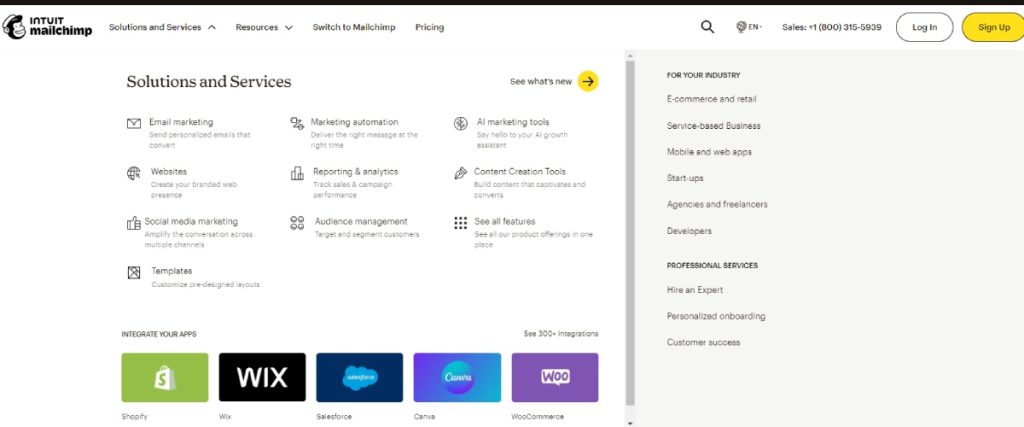
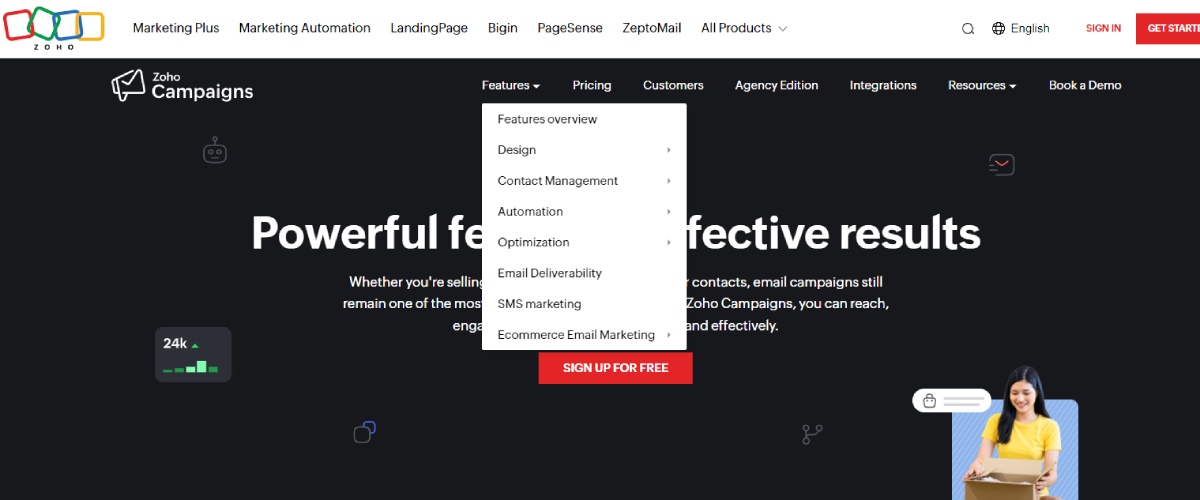
User Interface and Ease of Use
Mailchimp’s user interface stands out as a key strength, offering an intuitive and user-friendly experience that caters to users of all skill levels. This accessibility is particularly evident in its email template offerings, which include both classic and AI-assisted builders. The platform’s modern templates provide a wide range of design options, enhancing the overall user experience.
In contrast, Zoho Campaigns, while still user-friendly, presents a steeper learning curve, especially when it comes to advanced features. This difference in complexity can be a crucial factor for businesses considering which platform to adopt, particularly those with team members who may have varying levels of technical expertise. The ease of use in Mailchimp’s interface can lead to quicker adoption and more efficient campaign creation, potentially saving time and resources in the long run.
List Management and Subscriber Handling
List management is a critical aspect of email marketing, and here Zoho Campaigns shines with its efficient approach. Unlike Mailchimp, which manages lists as isolated “Audiences” that can result in duplicate contacts and increased costs, Zoho Campaigns allows subscribers to be part of multiple lists without duplication issues. This feature is particularly beneficial for businesses with complex segmentation needs or those running multiple campaigns across different product lines or services.
The ability to manage subscribers more flexibly can lead to more targeted and effective email marketing strategies. Additionally, this approach can help in maintaining a cleaner, more organized subscriber database, which is crucial for compliance with data protection regulations and for maintaining high deliverability rates. Zoho’s list management capabilities thus offer a significant advantage for businesses looking to optimize their email marketing efforts.
Automation Capabilities
Both Mailchimp and Zoho Campaigns offer robust automation solutions, but with different approaches. Mailchimp provides an extensive array of pre-built scenarios and visual editors, making it easier for users to create complex customer journeys without extensive technical knowledge. This simplification of automation workflows can be particularly beneficial for small to medium-sized businesses or those new to email marketing automation.
Zoho Campaigns, while requiring more effort to set up, offers a sophisticated workflow builder with various automation paths. This advanced capability can be advantageous for businesses with more complex marketing needs or those looking for highly customized automation sequences. The choice between the two platforms in terms of automation may depend on the user’s level of expertise and the complexity of the desired marketing workflows. Both platforms aim to streamline the process of creating automated email sequences, but cater to different levels of user experience and campaign complexity.
Pricing Structures and Value Proposition
Pricing is a crucial factor in choosing an email marketing platform, and here Zoho Campaigns offers a compelling advantage, especially for businesses with larger contact lists. Zoho’s pricing structure is generally more cost-effective, with some plans offering unlimited email sends. This can provide significant value for businesses that send high volumes of emails or have extensive mailing lists. In contrast, Mailchimp’s pricing can become more complex and potentially more expensive as subscriber counts increase.
This difference in pricing structure can have a substantial impact on the overall cost of email marketing campaigns, particularly for growing businesses or those with fluctuating subscriber numbers. The potential for unexpected costs with Mailchimp as subscriber counts grow is a factor that businesses need to consider carefully when planning their long-term email marketing strategy. Zoho’s more straightforward pricing model may offer more predictability and cost control for businesses managing large subscriber lists.
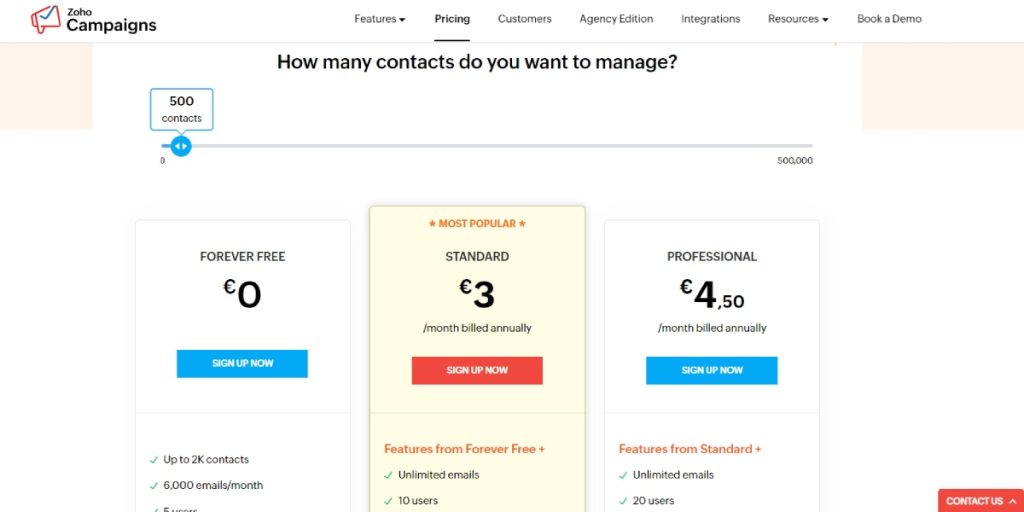
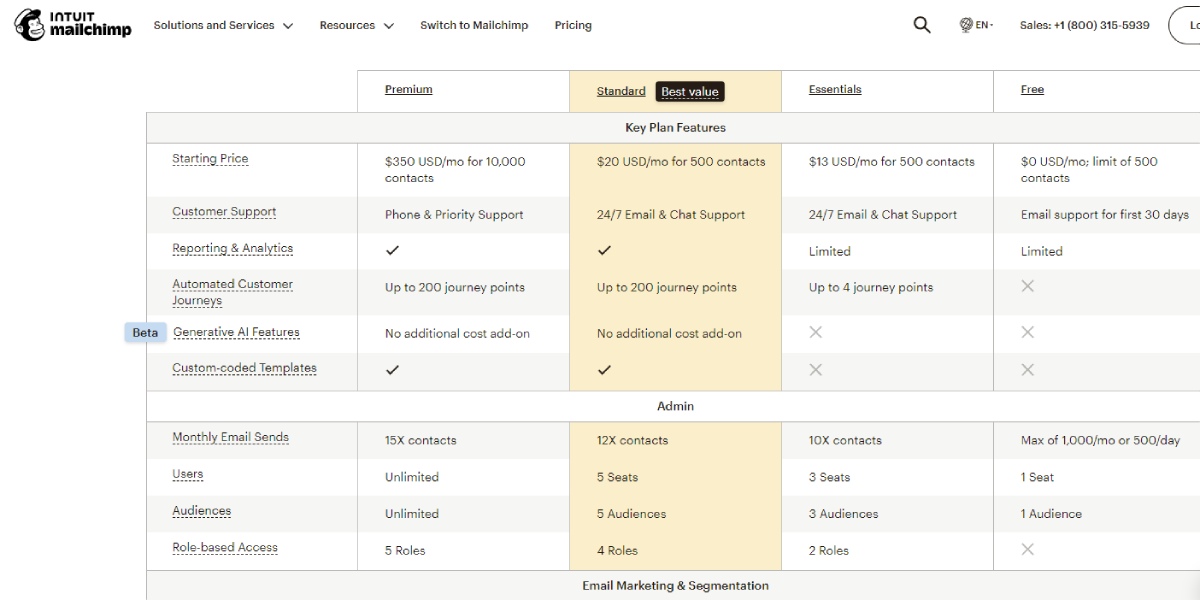
Integration Capabilities and Ecosystem Compatibility
Both Mailchimp and Zoho Campaigns offer strong integration capabilities, but with different strengths. Mailchimp boasts a wide array of third-party integrations, which can be a significant advantage for businesses using a diverse set of tools and platforms. This extensive integration ecosystem allows for greater flexibility and can enhance the overall functionality of email marketing campaigns by connecting with various other business tools.
On the other hand, Zoho Campaigns, while having fewer third-party integrations, excels in its seamless integration with Zoho CRM and other Zoho applications. This makes it an excellent choice for businesses already within the Zoho ecosystem or those planning to use multiple Zoho products. The tight integration within the Zoho suite can lead to more streamlined workflows and better data synchronization across different business functions. The choice between the two platforms in terms of integration may depend on the existing tech stack of a business and its future plans for software adoption.
Integration of Hidden Gems
Integrating lesser-known strategies can significantly enhance the effectiveness of email marketing campaigns. Here are five hidden gems from Mailchimp and Zoho Campaigns that can be leveraged for superior results:
- Dynamic Segmentation for Personalization: Utilize Zoho Campaigns’ advanced dynamic segmentation features to create highly personalized email lists based on real-time data. This approach allows you to target specific customer behaviors, improving engagement rates significantly.
- Utilize A/B Testing for Subject Lines: While both platforms offer A/B testing, focus specifically on testing subject lines in Zoho Campaigns. This can lead to better open rates as subject lines are crucial for grabbing attention in crowded inboxes.
- Automate Contact Management with Zapier: Use Zapier to automate contact updates between your website and Zoho Campaigns. For instance, automatically add new leads from a landing page to your email list, reducing manual entry and errors.
- Customizable Email Templates: Take advantage of Zoho’s customizable templates that allow for more flexibility than Mailchimp’s pre-designed options. Create unique email designs that reflect your brand identity more closely, leading to improved brand recognition.
- Use Behavioral Triggers for Automation: Implement behavioral triggers in Zoho Campaigns to send targeted emails based on user actions (like website visits or product views). This level of automation can significantly increase conversion rates by reaching customers at the right moment.
Innovative Solutions by Prism Reach
While Mailchimp and Zoho Campaigns offer robust solutions, Prism Reach emerges as an innovative alternative in the email marketing landscape. Prism Reach’s AI-powered personalization takes email marketing to the next level, offering deep customization that goes beyond what traditional platforms provide.
Prism Reach’s ability to create detailed user avatars and generate personalized content based on subscriber behavior and preferences addresses a key challenge in email marketing: relevance. This level of personalization has led to impressive results, with publishers reporting up to 40% higher engagement rates.
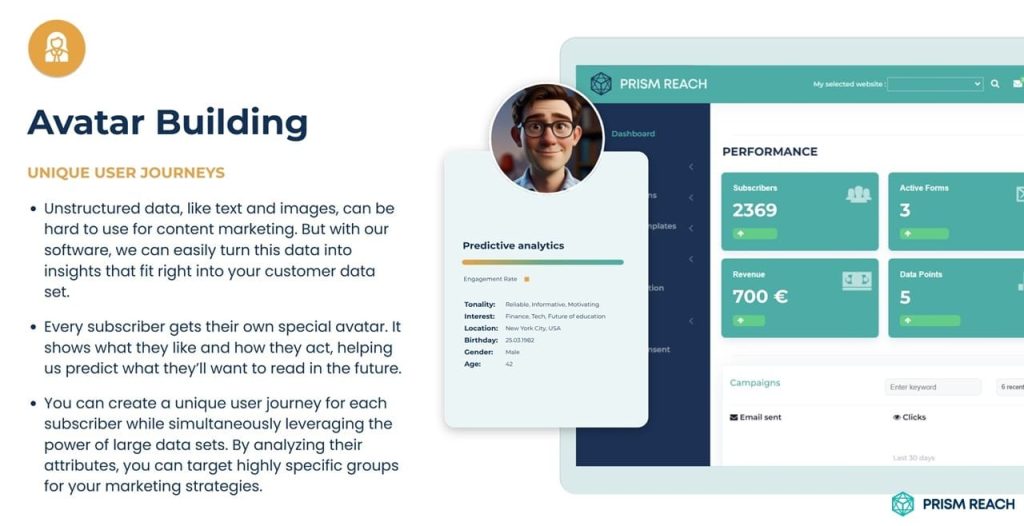
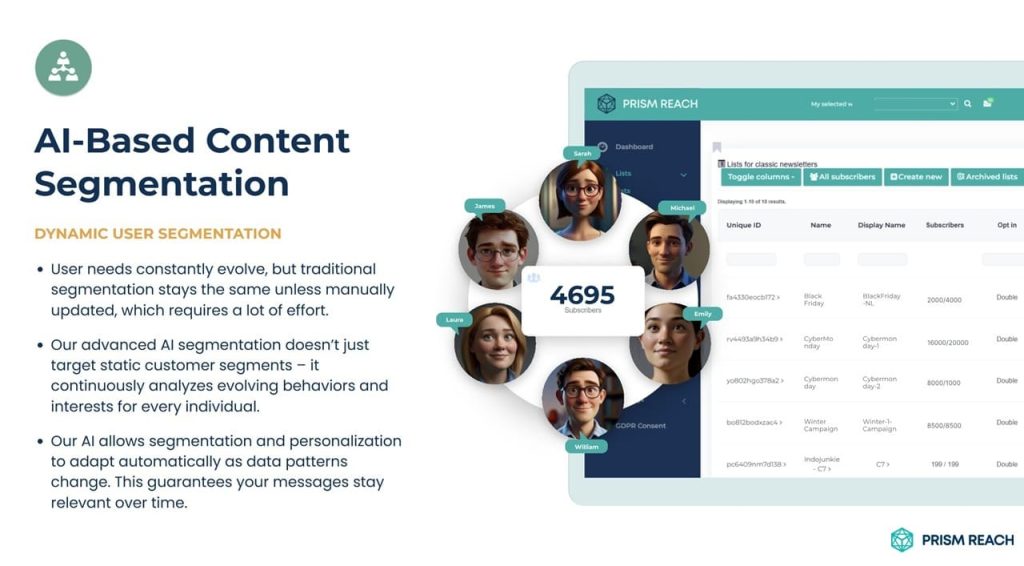
Moreover, Prism Reach’s focus on quick setup and seamless integration (with a 10-minute integration time) addresses the ease-of-use factor that makes Mailchimp popular, while its advanced AI features rival the sophisticated capabilities of Zoho Campaigns. The platform’s emphasis on GDPR compliance and data privacy also aligns with the growing concern for data protection in digital marketing.
Benefits of Prism Reach
- Increased Engagement: Publishers report up to 40% higher engagement rates due to the personalized nature of the content.
- Higher Revenue: Tailored advertising and efficient content targeting lead to higher monetization rates for published newsletters.
- Improved Productivity: Automation and AI-driven insights significantly reduce the time required to create and manage campaigns.
Potential Use Cases and Success Stories
Prism Reach has been instrumental in transforming email marketing strategies for various publishers and content creators. Here are some illustrative use cases and success stories:
Loly in the Sky: Personalized Marketing Success
Loly in the Sky, a popular lifestyle blog, utilized Mailchimp for personalized marketing but saw significant improvements when integrating Prism Reach. By leveraging Prism Reach’s AI-powered personalization, they were able to tailor their newsletters more effectively to individual subscriber preferences, resulting in a 35% increase in open rates and a 25% boost in click-through rates.
Omnichannel Marketing Integration
Businesses employing omnichannel marketing strategies found that integrating Prism Reach with their existing Mailchimp or Zoho Campaigns platforms enhanced their ability to deliver cohesive and personalized experiences across multiple channels. For instance, a retail company was able to synchronize email campaigns with social media and SMS marketing, ensuring a unified brand voice and consistent customer engagement.
Retail Strategies Enhanced by Prism Reach
Retailers using Zoho Campaigns have integrated Prism Reach to optimize their email campaigns further. By utilizing predictive analytics and dynamic content selection, they managed to better forecast inventory needs and tailor promotions to match customer buying behaviors, leading to more efficient inventory management and higher sales conversion rates.
Maximizing the Potential of Prism Reach

To fully leverage the capabilities of Prism Reach, businesses should consider the following strategies:
- Deep Dive into Customer Data: Utilize Prism Reach’s AI to analyze and cluster customer data, creating detailed user avatars that inform personalized content.
- Continuous A/B Testing: Implement A/B testing on various aspects of your email campaigns, such as subject lines, content blocks, and send times, to continually optimize performance.
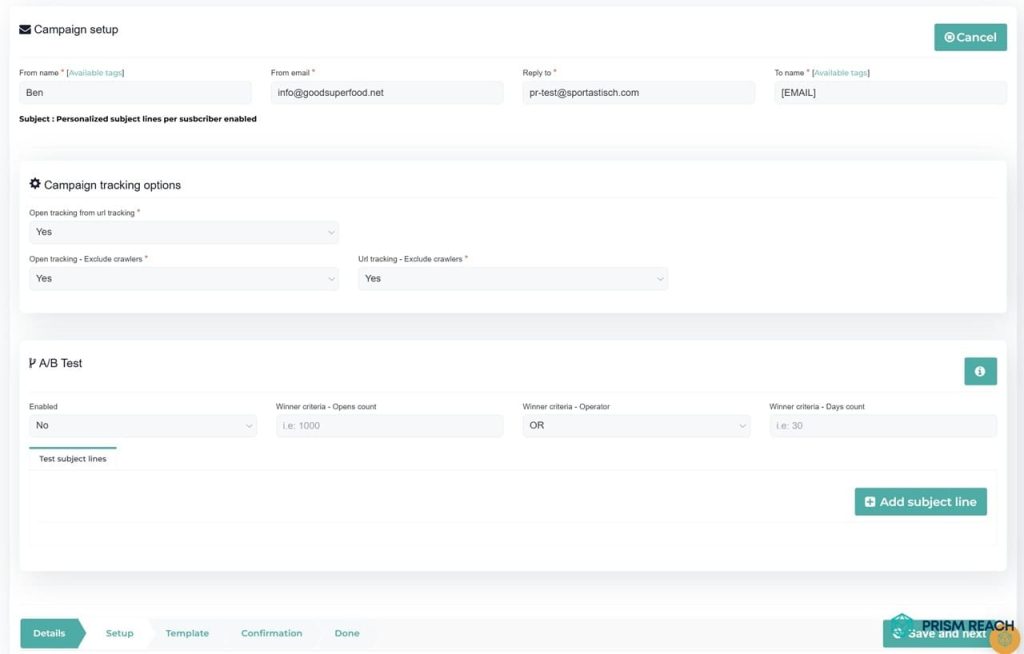
- Integrate Loyalty Programs: Enhance customer retention by integrating loyalty programs, automating personalized offers based on loyalty status, and tracking engagement to refine future campaigns.
Comparative Analysis: Mailchimp vs Zoho Campaigns vs Prism Reach
While Mailchimp and Zoho Campaigns are established players in the email marketing automation space, Prism Reach introduces innovative features that address some of the limitations of these platforms. Here’s how they compare:
- Personalization: Mailchimp offers AI-driven personalization with an emphasis on ease of use, Zoho Campaigns provides advanced segmentation and behavioral triggers, and Prism Reach delivers deep AI-driven personalization with user avatars.
- Ease of Use: Mailchimp has an intuitive interface suitable for non-technical users, Zoho Campaigns offers more advanced features that may require a steeper learning curve, and Prism Reach balances ease of use with sophisticated AI capabilities.
- Integration: Mailchimp excels with extensive third-party integrations, Zoho Campaigns integrates seamlessly within the Zoho ecosystem, and Prism Reach provides seamless integration with existing tools while enhancing their functionality.
- Analytics: Mailchimp provides comprehensive analytics with AI-driven insights, Zoho Campaigns offers advanced segmentation analytics, and Prism Reach enhances analytics with predictive insights and sentiment analysis.
- Pricing: Both Mailchimp and Zoho Campaigns use custom pricing models, whereas Prism Reach offers scalable pricing options tailored to mid-sized and small publishers.
Choosing the Right Platform for Your Business
When deciding between Mailchimp, Zoho Campaigns, and Prism Reach, businesses should consider the following factors:
- Business Size and Scale: Larger enterprises with existing Zoho systems may benefit more from Zoho Campaigns, while small to medium-sized businesses might find Mailchimp’s ease of use or Prism Reach’s advanced personalization features more aligned with their needs.
- Technical Expertise: Companies with technical teams may leverage Zoho Campaigns’ advanced features, whereas those seeking a more user-friendly interface might prefer Mailchimp or Prism Reach.
- Marketing Goals: Businesses aiming for deep personalization and AI-driven insights may find Prism Reach to be the best fit, while those focused on cost-effectiveness and integration with the Zoho ecosystem might lean towards Zoho Campaigns.
- Budget Considerations: Custom pricing models mean that businesses need to evaluate the cost-effectiveness of each platform based on their specific requirements and budget constraints.
- Support Needs: Consider the level of customer support required, as Mailchimp offers extensive resources and support, Zoho Campaigns provides integrated support within the Zoho ecosystem, and Prism Reach offers specialized support tailored to its innovative features.
Prism Reach: The Future of Email Marketing
Prism Reach represents a significant advancement in personalized email marketing technology. By leveraging AI to understand and predict subscriber preferences, Prism Reach delivers content that is not only relevant but also timely, enhancing the overall impact of digital marketing campaigns and fostering stronger connections between publishers and their audiences.
Looking ahead, Prism Reach aims to expand its technology into the eCommerce sector and explore new ways to leverage AI for broader marketing applications. The company is committed to the continuous improvement of its AI algorithms, ensuring that its solutions remain at the cutting edge of technology and marketing innovation.
Upgrade Your Email Marketing with AI Personalization!
Conclusion
In the Mailchimp vs Zoho Campaigns debate, the choice ultimately depends on specific business needs. Mailchimp shines with its user-friendly interface and AI-driven features, making it an excellent choice for beginners and businesses prioritizing ease of use. Zoho Campaigns, with its cost-effectiveness and strong integration with the Zoho ecosystem, is ideal for businesses already using Zoho products or those requiring advanced segmentation capabilities.
However, for businesses looking to push the boundaries of email marketing personalization, Prism Reach offers an innovative solution that combines ease of use with advanced AI-driven personalization. As the email marketing landscape continues to evolve, tools like Prism Reach that focus on deep personalization and engagement may well represent the future of the industry.